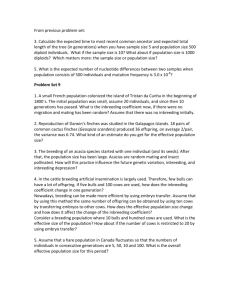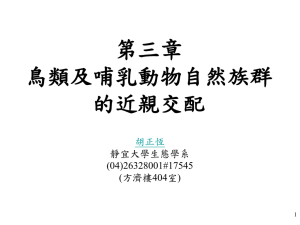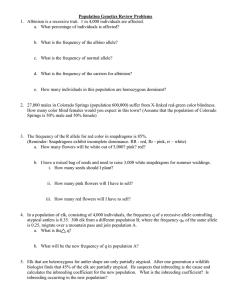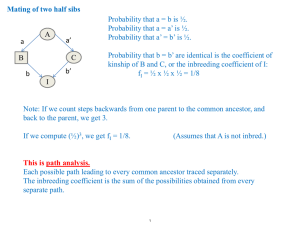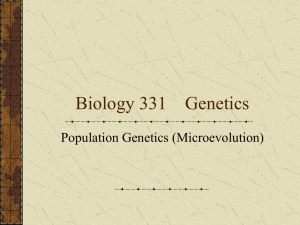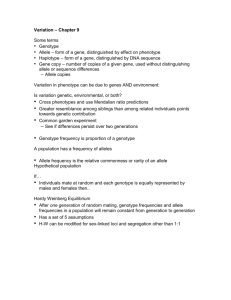Inbreeding effects on Hardy-Weinberg Equilibrium
advertisement
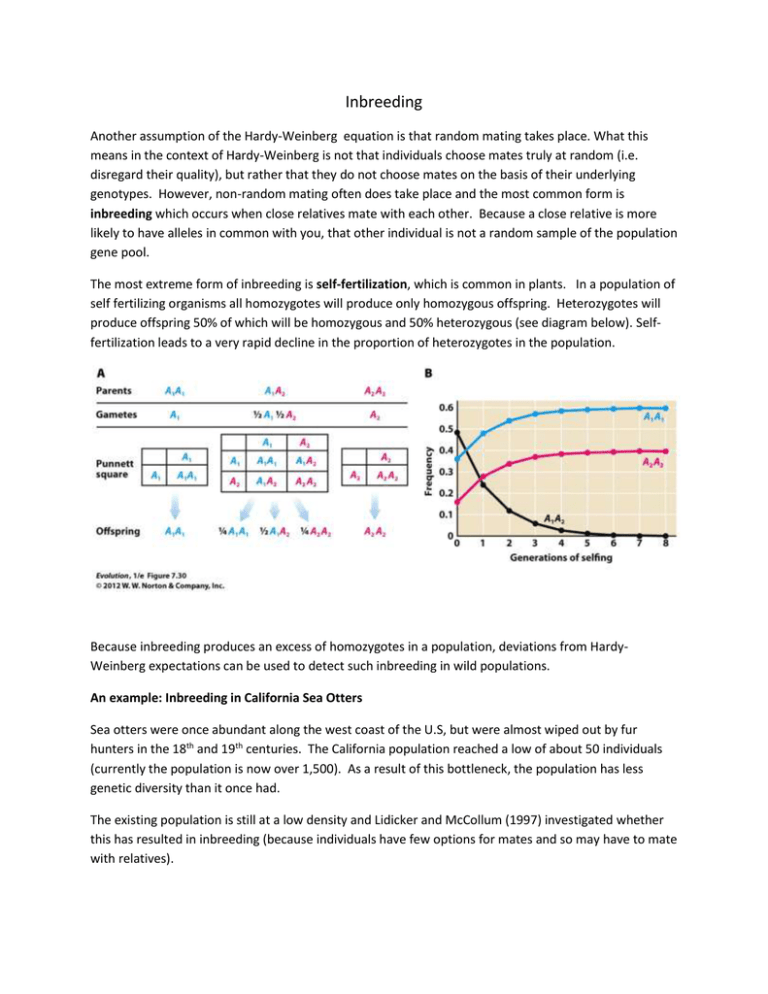
Inbreeding Another assumption of the Hardy-Weinberg equation is that random mating takes place. What this means in the context of Hardy-Weinberg is not that individuals choose mates truly at random (i.e. disregard their quality), but rather that they do not choose mates on the basis of their underlying genotypes. However, non-random mating often does take place and the most common form is inbreeding which occurs when close relatives mate with each other. Because a close relative is more likely to have alleles in common with you, that other individual is not a random sample of the population gene pool. The most extreme form of inbreeding is self-fertilization, which is common in plants. In a population of self fertilizing organisms all homozygotes will produce only homozygous offspring. Heterozygotes will produce offspring 50% of which will be homozygous and 50% heterozygous (see diagram below). Selffertilization leads to a very rapid decline in the proportion of heterozygotes in the population. Because inbreeding produces an excess of homozygotes in a population, deviations from HardyWeinberg expectations can be used to detect such inbreeding in wild populations. An example: Inbreeding in California Sea Otters Sea otters were once abundant along the west coast of the U.S, but were almost wiped out by fur hunters in the 18th and 19th centuries. The California population reached a low of about 50 individuals (currently the population is now over 1,500). As a result of this bottleneck, the population has less genetic diversity than it once had. The existing population is still at a low density and Lidicker and McCollum (1997) investigated whether this has resulted in inbreeding (because individuals have few options for mates and so may have to mate with relatives). They determined the genotypes of 33 otters for PAP locus, which has two alleles S (slow) and F (fast). The genotypes of the 33 otters were: SS 16 SF 7 FF 10 Counting up the alleles this gives approximate allele frequencies of S= 0.6 and F = 0.4. If the sea otter population was in H-W equilibrium, the expected genotype frequencies should be SS = 0.6* 0.6 = 0.36 SF =2*0.6*0.4 = 0.48 FF = 0.4*0.4 = 0.16 However observed genotype frequencies were: SS= 0.485, SF= 0.212, FF =0.303 There are more homozygotes and fewer heterozygotes observed than expected for a random mating population. Having considered alternative explanations for deficit of heterozygotes Lidicker and McCollum (1997) concluded that sea otter populations show evidence of inbreedng. Self-fertilization and sibling mating most extreme forms of inbreeding, but mating between more distant relatives (e.g. cousins) has the same effect on frequency of homozygotes, but rate is slower. Alleles being identical by descent A central concept in inbreeding is the idea that the offspring of relatives will have a higher level of homozygosity than the offspring of non-relatives. A certain baseline level of homozygosity occurs in members of any population simply because there are for most genes only a few different alleles. However, inbred offspring have on top of this baseline level of homozygosity, an additional layer of homozygosity that occurs because they end up inheriting multiple copies of the same allele from one particular recent ancestor. These alleles are said to be identical by descent. This extra level of homozygosity is frequently harmful because if an ancestor has a copy of a recessive harmful allele and through inbreeding a descendant inherits two copies of that allele (is homozygous for it) the descendant will express the harmful condition. The level of inbreeding in a particular situation is given by F the coefficient of inbreeding. F = Coefficient of inbreeding: probability that two alleles in an individual are identical by descent (i.e. both alleles are copies of a particular ancestor’s allele in some previous generation). F increases as relatedness increases. If we compare the heterozygosity of an inbred population Hf with that of a random mating population Ho (also known as an outbred population, hence the o subscript in Ho) the relationship is Hf = Ho (1-F) Anytime F>0 the frequency of heterozygotes is reduced and frequency of homozygotes naturally increases. Calculating F. Need to use pedigree diagrams. Example: Female is daughter of two half-siblings. Two ways female could receive alleles that are identical by descent i.e two copies of the same allele (triangle or diamond) in the diagram below. The diagram above gives the probability that the offspring will have two copies of the triangle allele (1/16). The same calculation can be made for the diamond allele so the overall probability that the individual is homozygous for either the triangle or diamond allele is 1/16 + 1/16 = 1/8, which is F. Inbreeding exposes deleterious alleles to selection Inbreeding increases frequency of homozygotes and thus the probability that deleterious alleles are visible to selection. In humans, children of first cousins have higher mortality rates than children of unrelated individuals. Each dot on the graph represents the mortality rates for a human population. Mortality rate for children of cousins is consistently about 4% higher than rate for children of non-relatives. Inbreeding effects on high blood pressure In a study of 2760 individuals from 25 Croatian islands Rudan et al. (2003) found a strong positive relationship between high blood pressure and the inbreeding coefficent. Inbreeding in royal families Royal families have been particularly prone to inbreeding. In Ancient Egypt because royal women were considered to carry the royal bloodline the pharaoh routinely was married to a sister or half-sister. The most famous example of a genetic disorder exacerbated by inbreeding is the Hapsburg jaw or Hapsburg lip [severe lower jaw protrusion] . (Hapsburgs were the ruling family of Austria and Spain for much of the 1400’s-1700’s). Extensive intermarriage of close Hapsburg relatives occurred. The last of the Spanish Hapsburgs, Charles II (1661-1700) had such severe jaw protrusion he could not chew his food properly. Charles II also had a large number of other recessively inherited genetic problems that caused physical, mental, sexual and other problems. Charles was infertile and the last of the Spanish Hapsburg kings.
